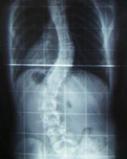How is Scoliosis tested for?

A x-ray of someone with Scoliosis.
· First, your doctor will run their finger down your spinal column to make sure it is in proper alignment. If there is a nonalignment of the spine, then further tests will be done to see the extent of your scoliosis. These tests include the Adams Forward Bend Test. This screening test is used most often in schools and in the offices of pediatricians and primary care physicians. The Adams Forward Bend Test requires the patient to bend forward dangling the arms with the feet together and knees straight, because the curve of structural scoliosis is more apparent when bending over. In a child with scoliosis, the examiner may observe an imbalanced rib cage, with one side being higher than the other, or other deformities. Any imbalances in the rib cage or other deformities along the back could be a sign of scoliosis. The forward bend test, however, is not sensitive to abnormalities in the lower back, a site common for having for scoliosis. Because the test misses about 15% of scoliosis cases, many experts do not recommend it as the only method for screening for scoliosis. Other physical tests include:
o The patient being requested to walk on their toes, then the heels, and jump up and down on one foot. Such activities indicate leg strength and balance, things that suggest you do not have scoliosis.
o The physician will also check leg length and look for tighttendons in the back of the leg, which may cause an uneven leg length or other back problems.
o The physician will also check for neurologic impairment by testing reflexes, nerve sensation, and muscle function.
o Doing these tests can prevent misjudgment, which can lead to unnecessary x-rays and stressful treatments in children not actually at risk for progression of Scoliosis. Unfortunately, although measurements of curves and rotation are useful in determining the degree of Scoliosis, no test exists yet that can determine whether a curve will progress. An inclinometer, also known as a Scoliometer, measures distortions of the torso. The which is used as described below:
1. The patient will bend over, arms dangling and palms pressed together, until a curve can be observed in the upper back.
2. The Scoliometer is placed on the back and measures the apex (the highest point) of the upper back curve.
3. The patient continues bending until the curve can be seen in the lower back. The apex of this curve is also measured.
4. Measurements are repeated twice, with the patient returning to a standing position between repetitions.
5. If results show a deformity, x-rays probably need to be performed to determine the extent
Currently, x-rays are the most cost efficient method for diagnosing scoliosis. However, though x-raying has been found to be fairly accurate for detecting scoliosis in the upper back it is less accurate for detecting scoliosis in the lower back.
To see what causes Scoliosis click the link labeled "Causes of Scoliosis" seen above or click here.
o The patient being requested to walk on their toes, then the heels, and jump up and down on one foot. Such activities indicate leg strength and balance, things that suggest you do not have scoliosis.
o The physician will also check leg length and look for tighttendons in the back of the leg, which may cause an uneven leg length or other back problems.
o The physician will also check for neurologic impairment by testing reflexes, nerve sensation, and muscle function.
o Doing these tests can prevent misjudgment, which can lead to unnecessary x-rays and stressful treatments in children not actually at risk for progression of Scoliosis. Unfortunately, although measurements of curves and rotation are useful in determining the degree of Scoliosis, no test exists yet that can determine whether a curve will progress. An inclinometer, also known as a Scoliometer, measures distortions of the torso. The which is used as described below:
1. The patient will bend over, arms dangling and palms pressed together, until a curve can be observed in the upper back.
2. The Scoliometer is placed on the back and measures the apex (the highest point) of the upper back curve.
3. The patient continues bending until the curve can be seen in the lower back. The apex of this curve is also measured.
4. Measurements are repeated twice, with the patient returning to a standing position between repetitions.
5. If results show a deformity, x-rays probably need to be performed to determine the extent
Currently, x-rays are the most cost efficient method for diagnosing scoliosis. However, though x-raying has been found to be fairly accurate for detecting scoliosis in the upper back it is less accurate for detecting scoliosis in the lower back.
To see what causes Scoliosis click the link labeled "Causes of Scoliosis" seen above or click here.
